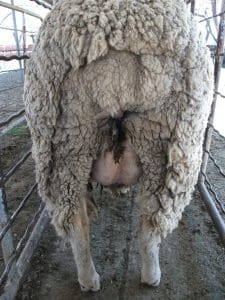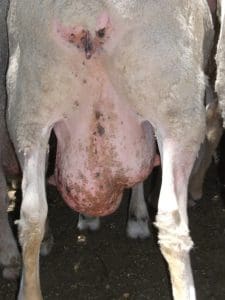
A Merino ewe with good udder development.
EWE udder assessment is the ‘hidden gem’ among strategies available to Merino producers to maximise reproductive success, according to senior New South Wales research scientist Dr Gordon Refshauge.
This week the NSW Department of Primary Industries and Regional Development’s Cowra Agricultural Research and Advisory Station reported it has had one of its most successful breeding seasons to date.
The 1000-ewe Merino flock at the research station achieved an overall lamb marking rate between 130-140 percent per ewe joined, well above the national lamb marking average of 90pc for Merinos, that can vary significantly with local and seasonal conditions.
Dr Refshauge, the senior research scientist with NSW DPIRD’s Livestock Systems division, said the excellent results showcase the effectiveness of the ongoing research and management practices implemented by the department’s research team.
“The Cowra Agricultural Research and Advisory Station staff’s dedication and expertise are driving performance well above the industry average,” he said.
“Staff categorised pregnant ewes into groups based on litter size of singles, twins, and multiples and provided feed quality and quantity tailored to each group’s specific needs.
“The combination of these strategic practices, alongside a healthy and well-managed flock, led to a successful lambing season, showcasing the station’s commitment to maximising lambing potential,” he said.
Genetics and the value of a good udder
The 2024 Cowra flock results build on six years of strong lamb marking and weaning results and can be largely attributed to flock and pasture management despite the slow early winter pasture growth and the cold, wet and windy winter conditions experienced in late June and early July. It was also enhanced by tactical use of forage crops and optimal use of pregnancy scanning data.
But the genetic background of the Cowra flock and ongoing selection for reproduction success and udder health has also underpinned the lambing results.
Dr Refshauge said in 2007 the station brought sheep across from the Trangie QPLU$ Project and topped them up with some Centre Plus ewes over the five-year Information Nucleus Flock project that used rams from ASBV-based studs selected for genetic variability.
“Then we bred back to Centre Plus from there, placing emphasis on rearing ability.”
Initially ewes were culled if they twice failed to get pregnant or rear a lamb, and now Cowra culls if a ewe fails once, Dr Refshauge said.
“We were chasing the older Merino-Plus Index breeding objective which is in the middle of a dual purpose and fibre focus.”
He said the Cowra flock is also being bred for lower breech wrinkle so mulesing can be ceased, while maintaining productivity.
“So we keep an emphasis on sire that have got high fleece weights, low-moderate micron and we can get low worm egg count we go for that as well.
“So in this modern type of selection index we are not really with a huge emphasis on any single trait, it’s a balance.”
He said the Centre Plus focus on higher litter sizes allows the Cowra flock to produce its higher pregnancy scanning rates, around 165pc.

A ewe with an imbalanced udder needing further inspection.
Dr Refshauge said the emphasis he has placed on udder quality – ensuring teats/udders are functional and ewes are rearing lambs with no udder or teat anomalies or faults — “just pulls together the package” that includes strategic management decisions according to litter size.
“It (udder assessment) is a hidden gem, but the trouble is the best time to do it is at marking
“Firstly, you need controlled mating (five week or two cycle mating), you can’t do it with continuous (ram) exposure.”
Dr Refshauge said udder assessment is problematic for the industry because some producers mate for three cycles, which changes the type of information manager’s get.
“Udder assessment I think is absolutely critical – of all the tools that I can choose to improve my reproduction rate, number one is udder assessment.”
This includes assessments of wet/dry vs lambed and lost, whether a ewe is lactating in one or both teats, bottle or blind teats, mastitis, blocked teats and soft or hard udder lumps.
“If we found reproductive rates were higher we would start culling anything that has a lump forming, but I’ll keep an eye on it.
“We won’t join anything with a bottle teat or with mastitis and I’m starting to keep an eye on udder depth as well – I don’t want it too deep or too short – I want a deeper udder somewhere between halfway to the hock.”
Dr Refshauge said the benefits of selection based on udder selection are seen very quickly.
“If producers haven’t been applying any pressure to udders, and you start making the assessments and paring out the ewes that aren’t structurally sound, it doesn’t take terribly long; a couple of years.
“You immediately fix the cohort and it will improve from there.
“Of course that is contingent on the ram bloodline and the emphasis the ram breeder is placing on the udder as well.”
He said “too few” Merino ram breeders placed an emphasis on udder structure in their selection, because marking is a busy time.
Dr Refshauge said leaving udder assessments until weaning, after weaning, or at crutching or shearing, information is missed. He said when producers ask him about low marking numbers after high scanning rates, the first thing to find out is if they distinguished dry ewes from those that lambed and lost by assessing udders.
“That’s important because if your dry percentage is more than 5pc (in scanned lambing ewes), you’ve got a reproductive disease.”
With the passage of time a lambed-and-lost ewe starts to look like she was dry, he said.
Dr Refshauge said he senses that more crossbred flock producers are assessing udder than Merino growers, but he said with the new ewe lamb-rearing ability breeding value, producers can ask for information around that.
He said good records on individual ewe performance across various traits avoided culling on single trait performance alone and ensured a balanced approach to selection.
An unusually high number of triplets and quadruplets
This season, the station’s flock exhibited lower pregnancy rates than normal but also an unusually high number of triplets and quadruplets.
“We had a dry spring last year so we drafted at weaning our fat and lean ewes and tried to take fat off our fats and get our leans up, and then with above average rain in November-December-January-February.
“So we came into joining with all those animals above average in condition – too heavy – and that decreased our pregnancy rate and increased our triplets.”
Dr Refshauge said some twinning mobs marked 180pc and averaged the high 90s in the singles mobs.
“So the ewes performed really well to get us to 133pc (marked overall) given the slow start, because we had an 11pc not pregnant rate.”
Dr Refshauge said the high percentage of ewes with triplets and quads can be attributed to the ewes being in excellent condition prior to mating and continuing to gain weight during the mating period.
“Due to limited pasture growth, and high feed demands, the ewes were placed in their lambing paddocks earlier than usual, after finishing grazing mixed species forage crops or dual-purpose canola.
“These pre-lambing management decisions were critical for lambing, as pastures had been rested from grazing for 4-6 weeks prior to the commencement of lambing and the ewes were in the right body condition for lambing,” he said.
“By integrating these precision management strategies with optimal feeding practices, we’ve exceeded our lambing goals for 2024, showcasing the capability of our flock and team and hoping to continue this for years to come.”
For more information on the NSW DPIRD Cowra Agricultural Institute, please visit the website

HAVE YOUR SAY